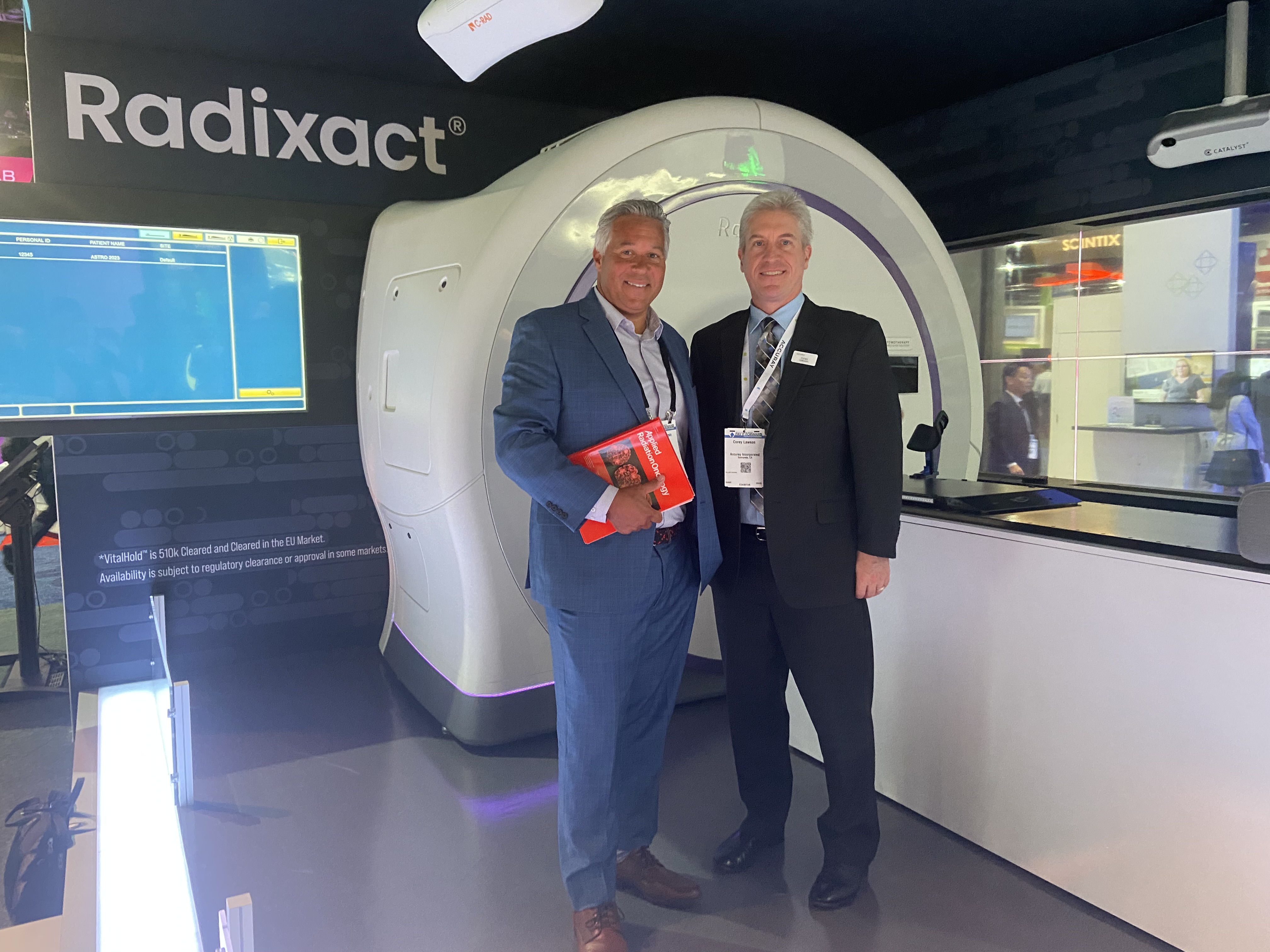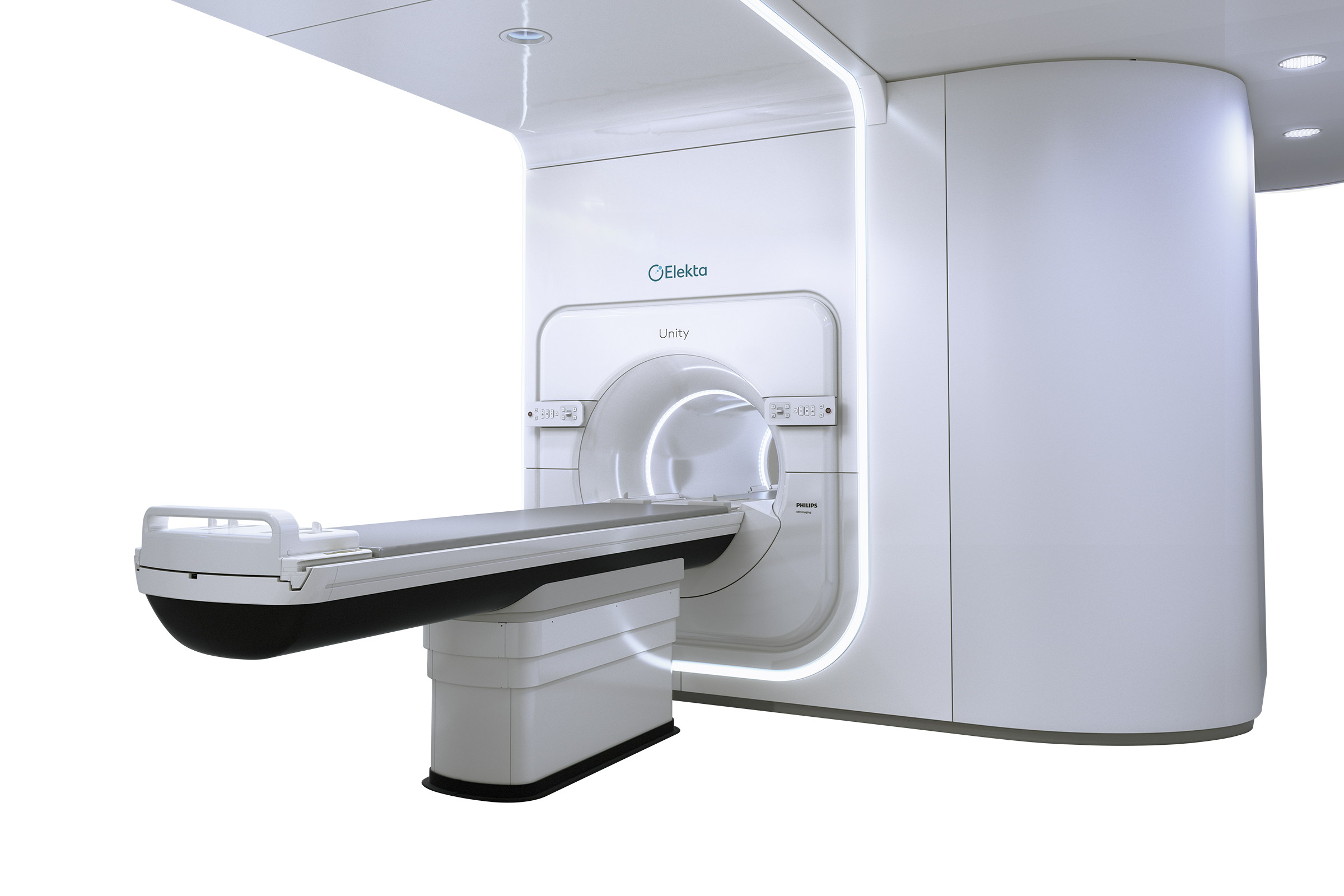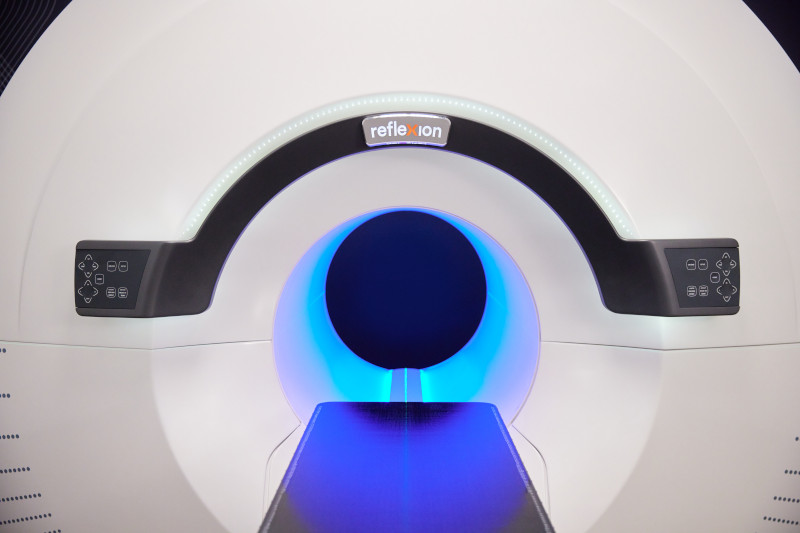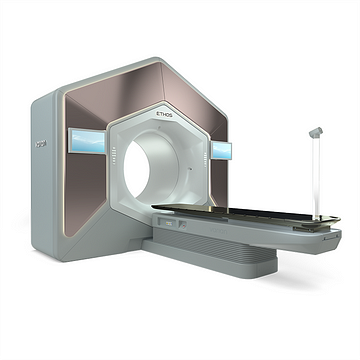Exhibitors Showcase Technology Advances at ASTRO
Images





At the 65th ASTRO Annual Meeting held October 1-4 in sunny San Diego, the theme “Pay it Forward: Partnering with Our Patients” underscored many of the educational panels, keynote addresses, and special conference sessions. The theme’s message was also evident in the exhibit halls where vendors highlighted innovative treatment strategies, workflow improvements, and new technologies to augment personalized patient care. Here’s a look at exhibit hall highlights.
Accuray
Accuray introduced a major development for its Radixact System called VitalHold, a new, approved functionality enabling deep-inspiration breath-hold treatments used most notably in women with left-sided breast cancer, explained Corey Lawson, vice president of product strategy for Accuray.
“Anytime you’re delivering radiation in close proximity to the heart, there’s potential for having cardiac disease years down the road,” Lawson said, explaining that based on the patient’s chest wall position, the solution turns the beam on and off automatically.
“Radixact was always known for being able to treat really complex cases…breast cases included—and now, with VitalHold, you’ve got the ability to do simple tangential treatments using breast breath-hold technique,” he explained. “It’s one of the most comprehensive breast treatment systems in the market,” which will enable efficient treatment and improved throughput of difficult cases at institutions of all sizes, he said.
The Radixact System offers compromise-free capabilities to treat the full spectrum of breast cases in as little as 2 minutes, leveraging both TomoHelical (helical delivery) and TomoDirect (tangential beams).
Also showcased at the Accuracy booth was Cenos, an online adaptive therapy option, also for Radixact, that is 510(k) pending.
“Cenos conveys, using a very simple dashboard, a patient’s dosimetric status [on the table] against the original plan,” Lawson said. “The system automatically does an assessment of that patient for today’s treatment...looking at all the past fractions that have been delivered and is accumulating how much dose this patient would get if they would get this delivery today,” he told Applied Radiation Oncology. He also noted remote collaboration tools that enable efficient workflow for teams that may not be collocated.
Elekta
Elekta displayed hardware and software technologies at its booth, shared theater presentations, and hosted a women’s networking event at ASTRO. The company highlighted several abstracts by Unity MR-linac clinical users, who detailed how the solution’s online plan adaptation and Comprehensive Motion Management (CMM) have improved capabilities of the high-field system. At the booth, a unified user experience took center stage on the software front with the North American introduction of Elekta ONE, acomprehensive, advanced software portfolio of end-to-end solutions.
“As we are now road mapping toward adaptive solutions…it became critically important that our software portfolio is integrated and our customers can really boost productivity using Elekta ONE,” said Anish Patankar, senior vice president and the head of Business Line Software for Elekta, adding that personalization of every treatment through the software would not be compromised for workflow gains.
Elekta demonstrated how it has innovated around MOSAIQ, their radiation oncology health information system, to generate improvements in workflow which include protocolization and orchestration of treatment, efficacy of treatment applications, and a focus on real-world outcomes—leveraging data in clinical insights, financial insights, operational insights, registry data, and patient-reported outcomes. Patankar noted that while software was traditionally perceived as a “necessary evil” for running the machine and recording and verifying treatment, it’s become so much more for clinicians and patients alike.
“Software powers every aspect of productivity and outcomes in the hospital, including in radiation oncology,” he said, noting that “[Elekta] believes in open interoperability and an open ecosystem.”
Patankar also noted the company’s focus on interoperability and a consistent user experience, which enables customers to choose from tiered packages of functionality. “We make it easy for [customers] to do business,” he said. “We’re using our software portfolio to really transform the way our clinics can do business and run the clinic.”
RaySearch Laboratories
RaySearch Laboratories showcased its latest updates to RayStation 2023B, which comes with automatic field-in-field planning, optimization via robust linear energy transfer (LET), and support for discrete proton arcs, among other improvements. The company also highlighted its RayCare oncology information system, which enables clinics to leverage their centralized treatment planning suite, and its RayIntelligence cloud-based analytics system.
During ASTRO, RaySearch also announced 3 key collaborations. The company’s long-term partnership with the EBG MedAustron GmbH in Wiener Neustadt, Austria, expanded via a new research agreement. RaySearch also expanded its collaboration with P-Cure for seamless integration with its proton therapy system. It announced a continued commitment with Mevion Medical Systems to support advancement of innovative solutions for HYPERSCAN IMPT [intensity modulated proton therapy], adaptive therapy, proton arc therapy, and FLASH proton therapy.
RefleXion
RefleXion showcased its SCINTIX biology-guided radiation therapy (BgRT) system that uses live, continuously updated data during the treatment session to determine where to deliver radiation therapy. After receiving FDA clearance for lung and bone tumors in February, the company upgraded its X1 machines in the field, which had been used for intensity modulated radiation therapy and stereotactic body radiation therapy, to also include SCINTIX therapy.
The first patient with lung cancer was treated with SCINTIX at Stanford in November, reported Sean Shirvani, MD, chief medical officer of RefleXion, who noted a handful of other US sites where their solutions are in use. The company is collecting imaging, biomarker, and clinical data on patients who undergo treatment with SCINTIX to further explore and push boundaries with their technology, he said.
“As we look to the future, we recognize this is a very versatile platform, not just for FDG, but for other radiotracers,” said Shirvani. “There’s a huge industry-wide effort to create many more radiotracers for diagnostic and therapeutic purposes, so it gives us an opportunity to ride that wave and create more versatility in our system.
RefleXion is also working to expand the versatility of its platform to additional anatomic regions, bring other radiotracers on their label, and carve out new radiation therapy applications.
“We’re really excited about eventually using our system to address metastatic cancer in an efficient, scalable way,” he said.
TAE Life Sciences
TAE Life Sciences, a pre-clinical company, discussed the use of boron neutron capture therapy (BNCT), which uses a drug to deliver boron 10 to cancers that are difficult to treat. Historically, an infusion occurs 3 hours prior to neutron irradiation, which doesn’t significantly affect healthy tissues but interacts with the isotope, explained Robert Hill, CEO of TAE Life Sciences.
“When a neutron hits a boron 10 atom, it creates a reaction inside the cell that emits an alpha particle and a lithium-7 nucleus. Those particles are energized to around 200,000 volts, and they deliver all of that energy over a range of 5-9 microns. So if you can get enough boron into the cells and treat them with enough neutrons, you can destroy the tumor cells,” Hill said, noting that challenges to the process include scalability and expense.
The company is working on new delivery mechanisms and a new accelerator solution, pending approval, as well as an antibody-based development program to target tumors. Their initial indication will likely be head and neck cancer, Hill reported, followed by glioblastoma. There are hundreds of international publications covering BNCT with “some really interesting results,” he said. “Over time, this has the potential to change things a lot with how radiation therapy is practiced.”
Varian
Varian, a Siemens Healthineers company, announced 5 product iterations across its portfolio:
- The HyperSight imaging solution, pending FDA 510(k) clearance for use on the TrueBeam and Edge radiation therapy systems, gives users access to better image quality, more precise images with greater contrast, and speed with shorter image acquisition time.
- The latest Ethos release, pending, provides dose calculation on high-quality cone-beam CT imaging when used with the HyperSight imaging option and extended AI segmentation.
- The MAGNETOM Free.Max RT Edition, pending, will bring access to MR imaging capabilities at a lower total cost of ownership and excellent soft-tissue contrast.
- The next generation of ARIA unifies data, diverse resources, and expertise across oncology disciplines to empower personalized care.
- The Eclipse treatment planning system has improved leaf modeling and automation for enhancements to conformity, accuracy, and efficiency in complex treatment planning.
Varian also announced its acquisition of Aspekt Solutions, a provider of medical physics, dosimetry, and strategy consultation services, enabling a holistic approach to care. More info can be found here.